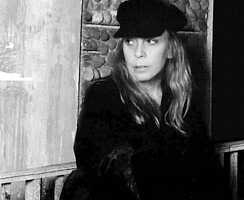Chuck E. Weiss And Rickie Lee Jones
"Oh, he's a lucky guy, I wish I was like him.
Cuz when he talks about me, He don't look this way.
He's a lucky guy"
Chuck E. Weiss born in Chicago, grew up in Denver. As a teenager he sat in on drums during a nightclub appearance in Denver by Lightnin' Hopkins. By the late '60s, Chuck E. Weiss had toured with Hopkins, and found himself performing with the likes of Willie Dixon, Muddy Waters, Dr. John (Mac Rebennack), Roger Miller and others.
Art Fein (2003): "...When I arrived at the University of Colorado in 1965, I had a head full of oldies... There were few of us among the 17,000 campusites, and we gravitated to each other. One was Chuck Weiss, who had the enormous advantage of his dad owning a record store (!!!!) on the college Hill. Someone set up a contest between me and him, and I'll say I won bec this is my space. Actually, neither of us could know much about R&R history, bec all there was was our individual experiences. There were no annals for this info, people were not writing books about it. You just looked and listened and went to thrift stores."(1)
Waits and Weiss met at the now-defunct Denver club "Ebbet's Field" (probably around October 8, 1974, when Waits was scheduled to perform there). The Ebbet's Field nightclub, located at 15th and Curtis, in Denver is long gone. It seems one Barry Fey and one Chuck Morris (both local Denver promoters) bought "Marvelous Marv's", a sunken cave of a room beneath Brooks Towers. Morris renamed the club Ebbet's Field in honor of the Brooklyn Dodgers ballpark near where he grew up. They featured bands such as: Lynyrd Skynyrd, Marshall Tucker, Little Feat, Emmylou Harris & the Hot Band. Ebbet's Field never made much money, owing to a capacity of fewer than 250, but it earned "Club of the Year" honors from Billboard magazine in 1975 and 1976. Shortly thereafter, Morris and Fey sold the club.
Chuck E. Weiss (1999): "...I met Tom when we were both sitting at the counter of the little coffee shop next door to the club. I was wearing a chinchilla coat and 3-inch platforms and I thought he was just some bum folk singer. I remember braggin' to him about all the people I knew." (2)
One can imagine how Waits got to write Jitterbug Boy. It's not about Waits himself but about Chuck E. In 1976 Waits moved to the infamous now-defunct Tropicana Motel (Santa Monica Boulevard 8585, Los Angeles). The place had once been a legend in rock circles. Jim Morrison, Janis Joplin and Alice Cooper had all once made it their Hollywood base of operations. But the Tropicana had fallen on hard times again. Chuck E. lived in Chicago for a while and subsequently moved to Los Angeles (Silverlake section) but eventually moved to the Tropicana. The two met again and became friends. The reason for Weiss to move there was a little greasy-spoon diner next door called Duke's. Weiss fell in love with the menu and the atmosphere. It became his favorite hangout.
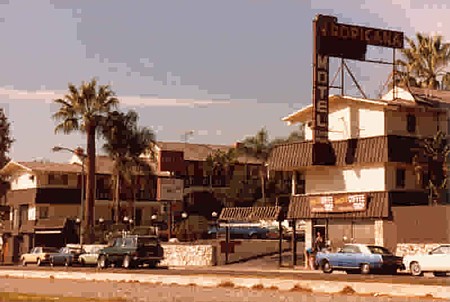
The Tropicana Motel (and Duke's Coffee Shop) on Santa Monica Boulevard 8585 (West Hollywood).
Source: Los Angeles Time Machine, 2006. Photo by "Joe of the UK"
Chuck E. Weiss (1999):"...That's why I moved there, because I was driving from Silverlake to there every day to eat, and I thought I'll just move there.." ..." About seven-eight months later Tom moved in. There were a lot of different people there. Sam Shepard, the playwright, was living there. The Dead Boys were living there. Lee Vi and the Rockats were living there. Pretty soon, Blondie would stay there. I'm sure this was because of Tom. As soon as he moved in, the place started to get an international reputation." (3)
By 1975 the two had become close friends. They started composing and writing together. Spare Parts I, which they wrote together, was released on 'Nighthawks at the diner'. In 1975 Weiss played with a short-lived band called 'The night caps'. Weiss probably didn't have a professional approach to this whole thing. Probably just trying to make some money and having fun (he was also working back in the kitchen of the LA Troubadour).
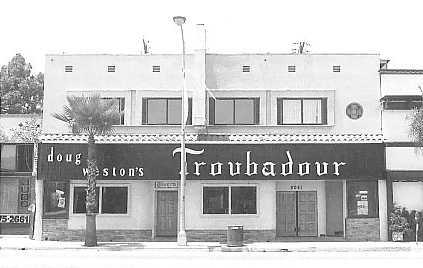
Early picture of The Troubadour at: 9081 Santa Monica Blvd., West Hollywood.
Picture as printed in Barney Hoskyns' "Waiting For The Sun". Penguin Books, 1996
Paul Body (2007): “...Chuckie was sort of Tom's road manager, and sort of his hanger-on. Well, not his hanger on but ... they were buddies, confidants. Chuckie was the wilder of the two, because Waits was still a kid. Weiss won't cop to it but he's a little older than us. Bighead [Body often referred to Weiss as "Bighead" because that’s what he once heard Muddy Waters call him] was a mentor for all of us in a way. He was really the street-smart guy... he knew all these guys and we didn’t.”(26)
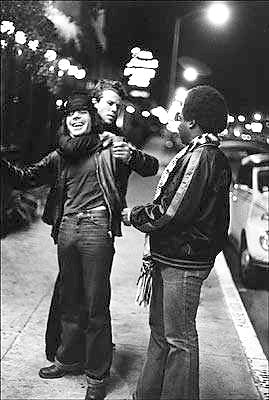
Tom strangles Chuck. outside the Troubadour. Paul Body watches.
Source: "Another Fein Mess/ Other Fein Messes" by Art Fein. March, 2003. Copyright Art Fein
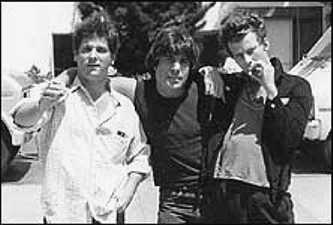
Art Fein, Chuck E. Weiss and Tom Waits not auditioning. Date: ca. 1977.
Source: "Another Fein Mess/ Other Fein Messes" by Art Fein. March, 2003. Copyright Art Fein
Robert Marchese (2007): "...Chuckie was doing a lot of drugs then. All I had to say was 'Where?' and he'd be there with the drugs before I even arrived. I only ever did LSD and cocaine. Chuckie didn't drink but he did anything else he could get his hands on. Him and Louie Lista would sneak off and take downers and whatever. Chuckie, because he wasn't really working or anything, was kind of drifting. I gave him a job at the Troub and I think he lasted a month.' Waits by contrast was faithful to alcohol and nicotine and certainly steered clear of heroin... He smoked like a chimney and once in a while he'd do a couple of lines, but Tom wasn't a druggie, I'll say that for him."(27)
Bones Howe (2007): "...Chuckie was a hanger. You'd meet a lot of actors that had walking around-people, they don't like to be alone. Tom liked having somebody to hang out with."(28)
Robert Marchese (2007): "...I can't say anything negative about Waits and Chuckie, but I always got the impression that once Tom rolled, then Chuckie would roll with him."(27)
Mike Melvoin (2007): "...I could never fathom what he was sellingl I didn't regard him as having any talent whatsoever except self promotion promoting his own celebrity. It was kind of saying, 'I am the street.' It was only two steps down to Wild Man Fischer as far as I was concerned” (29)
Bobi Thomas (2007): "...When Chuck came into Tom's life, he and I stopped hanging out so exclusively together. Little by little they became inseparable."(30)
Robert Marchese (2007): "...The image didn't mask the workaholic. Tom wrote constantly. He practiced a lot. He was on the scene and all that but he knew when it was time to work. For lack of a better word, Tom wanted to be a star. Chuckie was the farthest thing from that. He had no organizational skills and no direction.'”(27)
Tom Waits and Rickie Lee Jones first met late 1977. The two were romantically linked until 1980. Their affair got a lot of media attention in 1979. Waits being the beatnik hipster, already earning some early success with Small Change and Foreign affairs. And Rickie Lee Jones being the beautiful beret wearing beatress, having her first success with her self-titled debut album. Both in their twenties, they lived the jazz-beat-vagabond life as everyone wanted it to be.
Rickie Lee Jones was born in Chicago in 1954. After a troubled childhood, she landed in Venice, Los Angeles in 1973 at the age of nineteen. In Los Angeles she worked a series of waitressing jobs while occasionally performing in area clubs (Comeback Inn, A La Carte, Ivar Theatre) and writing songs for other artists. In the years to come she started writing more (beat influenced) songs and slowly developed a stage persona of her own. One evening in 1977 she was invited to sing at the famous Troubadour.
Rickie Lee Jones (late 1979): "...I didn't have any real friends back then [1977] and I didn't have any place to live. I didn't have any money. So I'd go sit over at the Tropicana motel and rest. A guy I know, Ivan Ulz, was performing at the Troubadour one evening and he asked me to come over and sing a couple of songs. This fella Chuck E. was working back in the kitchen of the club, and that's how I met him. I sang 'Easy Money' and a song Ivan wrote, called 'You almost look Chinese.' A little later on, Tom saw me there, and he and Chuck E. and I started hanging out together. That was a high point in my life. Before that, I guess I had learned not to depend on anybody else, 'cause once people start affecting what happens to you, it's trouble. But I think Chuck E. and Tom have been my family for a while now. It seems sometimes like we're real romantic dreamers who got stuck in the wrong time zone. So we cling, we love each other very much."(4)
Tom Waits (1979): "...The first time I saw Rickie Lee she reminded me of Jayne Mansfield. I thought she was extremely attractive, which is to say that my first reactions were rather primitive - primeval even. Her style onstage was appealing and arousing, sorta like that of a sexy white spade. She was drinking a lot then [1977] and I was too, so we drank together. You can learn a lot about a woman by getting smashed with her. I remember her getting her first pair of high heels, at least since I knew her, and coming by one night to holler in my window to take her out celebrating. There she was, walking down Santa Monica Boulevard, drunk and falling off her shoes. 'I love her madly in my own way - you'll gather that our relationship wasn't exactly like Mike Todd and Elizabeth Taylor - but she scares me to death. She is much older than I am in terms of street wisdom; sometimes she seems as ancient as dirt, and yet other times she's so like a little girl."(4)
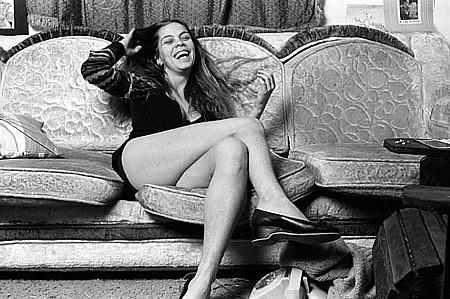
Rickie Lee Jones: Los Angeles, 1978. Photography by Norman Seeff.(Source: ©Norman Seeff official site)
In September 1978 Waits released Blue Valentine. The back cover and inner sleeve picture Waits and Jones posing as lovers (inner sleeve has Chuck E. Weiss in the back). The international press hadn't really noticed Rickie Lee Jones yet (or Chuck E. Weiss for that matter). Jones being on the cover of Blue Valentine was referred to as "the mysterious blonde". In the late 1970's Waits actually never mentioned her in interviews, nor did interviewers ask Waits about her. Blue Valentine has the Waits-Weiss-Jones trinity all over it. One might expect more direct references to their friendship, but there aren't any to be found.

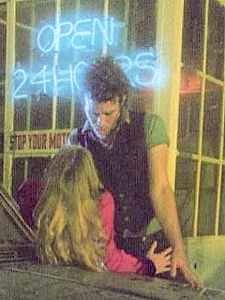
Tom Waits, Rickie Lee Jones and Chuck E. Weiss on the cover of Blue Valentine (released September, 1978).
Chuck E. Weiss (1979): "...She's all woman, and seems tough - I remember when she was broke and used to sleep under the Hollywood sign. But she's also real soft and playful. She and Waits and I used to steal the black lawn jockeys from homes in Beverly Hills and hop freight trains together. Once we three were at an exclusive party in the Hollywood Hills, invited there by Tom's lawyer, and Rickie went right in, sat down, and put an avocado between her legs. Tom was embarrassed but got a great kick out of it. Nobody would talk to us after that, so we spent the evening going up to people with cocktail dip hidden in our palms and shaking hands with them."(4)
Barney Hoskyns (2009): “...Among the trio's favourite pastimes was cruising Beverly Hills or Bel Air in search of lawn jockeys whose faces had been painted white by guilt ridden millionaires and movie stars. "Once upon a time they'd been black" Weiss recalled. "But instead of taking them down they'd painted them white. So Rickie and Tom and I would go around painting them black again' From there they progressed to actually stealing the jockeys. "I still have a couple in my back yard,' Weiss admitted almost thirty years later.”(31)
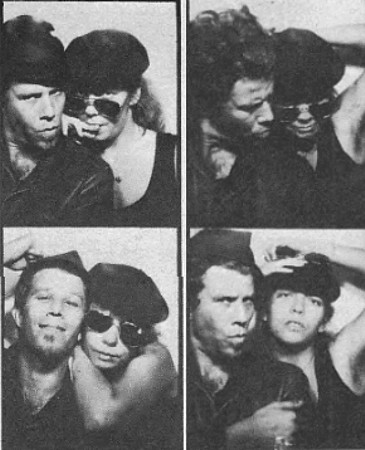
Source: Rolling Stone magazine. August 9, 1979. Credits: Rickie Lee Jones archives.
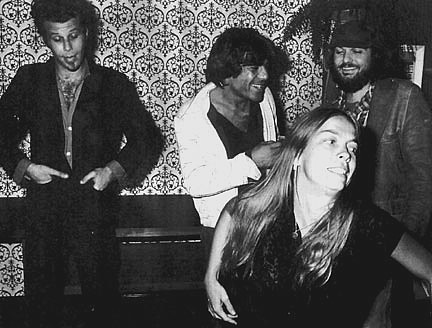
"The Other Side Of Town" demo sessions, arranged by David Ferguson.
With The Rebels (Colin Winski: guitar, Steve Clark:drums, Ken Jacobs: bass, Jerry Sikorski: guitar) and Dr. John.
Indigo Ranch Studios (Shangri-La Studios?) in Malibu, California. June/ August, 1979.
Tom Waits, Chuck E. Weiss, Rickie Lee Jones and Dr. John (Mac Rebennack)
Photo credit: Jenny Lens. Further reading: Jenny Lens Punk Archive
Lisa Clark (2005): "...Chuck E. Weiss and Steve Clark knew each other from the days when they were both recording at Rollin' Rock Records in Van Nuys, California during the early 70s. Chuck was working on some new songs and asked The Rebels to back him in the studio. He asked Tom, Rickie and John to help him produce the material."(20)
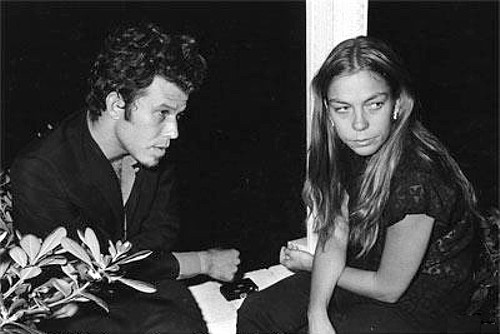
The Other Side Of Town sessions. Indigo Ranch Studios in Malibu, California. June/ August, 1979
Photo credit: Jenny Lens. Further reading: Jenny Lens Punk Archive
Waits, Weiss and Jones had become close friends in 1978. They were emotionally connected, shared the same sense of humour and adventure. Loved to party, loved to drink and loved the music. But there was no balance. Both Weiss and Jones were only just starting their careers. Waits however had already released 5 albums with Elektra/ Asylum. He had toured Europe, Japan and Australia. He'd been on the Mike Douglas Show, he'd been interviewed by Rolling Stone, he would soon have his first cameo in Sylvester Stallone's Paradise Alley. Waits would be touring 8 months a year, leaving behind Weiss and Jones in L.A.
During their relationship Waits and Jones couldn't have spent more than 16 or 17 months together. One can imagine Waits coming back home with wild stories and adventures Weiss and Jones could only dream of. Weiss probably never felt the urge to go for commercial success, but Jones definitely did. Part of her feelings for Waits might have come from her respect for Waits as a recording artist.
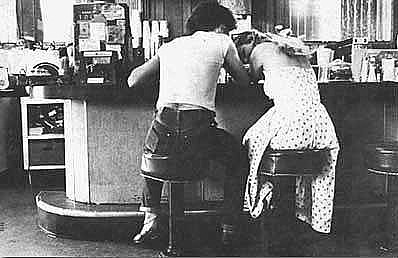
Chuck E. Weiss and Rickie Lee Jones at Duke's restaurant (Tropicana). Hollywood, ca. 1979
Source: Rickie Lee Jones Official Web Site. � Copyright 2000 Rickie Lee Jones
In 1978 and 1979 Weiss was often mentioned in intros to I Wish I Was In New Orleans and Jitterbug Boy. "...Chuck E. Weiss is the kind of guy that would steel his own car, huh huh huh" (Intro: I wish I was in New Orleans. Sydney March, 1979). In 1976 Weiss played with a band called "The Nocturnal Emissions". They were credited on "Small Change".
Rickie Lee Jones: "Favourite memories of 1978"(7)
Walking down La Brea and seeing Dr. John (Mac Rebennack) walk in my direction. I was wearing a beret, gloves, forties shoes. He had a beret, a cane with a mojo, a beard, and I was thinking, anybody seeing this? There we met on the street.
Swimming in the Tropicana pool late at night. I'd go over there and take off my clothes and swim in the pool, look up at the moon and imagine: so this is what it's like to be a movie star, to own the moon and the palms and the night air, to be beautiful and have the whole history of your life still approaching. Just swimming and imagining, being there, really being there in the water. I was bold. That's a good memory.
Then on my 24 birthday Lenny (Waronker) and Russ (Titelman) bought me two dozen red long stemmed roses in a box. I had never received roses and it was a thrilling gift. I think I saved them and the box for a long time. And they came to the studio, so there I was in a recording studio making my own songs with a dozen roses. You gotta know I was so poor and it was really cool. It still is.
I suppose when I went into Lenny's office (Lenny Waronker at Warner Brothers Records) and the only photo he had on his desk was me in a pretty black dress, that was a pretty great moment too.
Actually I guess the greatest moment of that year, and one of the greatest of my life, was the hour at the Troubadour that changed my life. I sang for 25 minutes or so. And then in the half hour or hour after everyone wanted to shake my hand, and said I was good and I could see in their eyes that I had made it. When I hear M&M sing that song about this moment comes once in a life time, I get all choked up. Not as choked up as when Cypress Hill sings 'Rock super star' tell me what happened when you lost clout no fans no change nor respect and everybody shits on your name. That song takes me there. So I'd say that moment when we knew we'd done it. Little Amy playing the piano and me singing when you wish upon a star. That was a great, great night.
In April 1979 Jones released her debut-album: "Rickie Lee Jones" (A&M/ Warner Bros. Co-produced by Russ Titelman and Lenny Waronker). At the time she was still living in a small Santa Monica apartment, though she probably spent most of her time at the LA Tropicana. On April 7, 1979 Jones appeared on The Saturday Night Live show (performing "Chuck E's In Love "). Within a couple of months Jones scored a hit with the single: "Chuck E's In Love" (which is about Chuck E. Weiss supposedly being in love with Rickie Lee Jones). On July 7 it reached 4th position in the American Top-40. Suddenly, Rickie Lee Jones had become an international star.
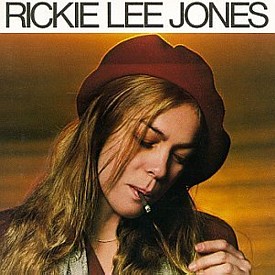
Rickie Lee Jones (A&M/ Warner Bros, 1979)
Chuck E. Weiss (2007): "...When I first heard it, she played it for me. Yeah, I was flabbergasted... Little did we know that all in all we would both be known for that, for the rest of our lives."(25)
Russ Titelman (late 1979): "...Rickie Lee was fairly wild, but you knew you were in the presence of something special. The sessions were spontaneous, explosive: she'd never done this before, she was just a kid with a guitar, but she knew exactly what she wanted. At the end of the session, we played through the album and she sat there and asked, "Is that me?""(4)
Chuck E. Weiss (2007): "...Though she never sounded like her, Rickie Lee was as much of an innovator as Joni Mitchell. She could move people so quickly. At shows, I used to watch people in the audience just crying their eyes out when she sang."(23)
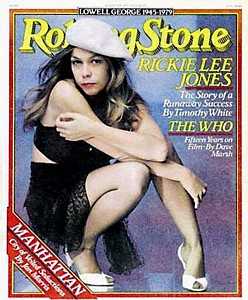
Rickie Lee Jones on the cover of Rolling Stone Magazine 297. August 9, 1979.
Photography by Annie Leibovitz
The press fell over her and she was going to tour. One can imagine how proud she must have been and one wonders how Waits felt about her success (Waits having 6 albums out, none of which ever reached hit status, and having toured for over 6 years).
Rickie Lee Jones (late 1979): "...I get compared a lot to Tom Waits, and I can understand it only from the point of view that we're both writing about street characters. Our writing and our singing styles have nothing in common, I think. But we walk around the same streets, and I guess it's primarily a jazz-motivated situation for both of us. We're living on the jazz side of life, the other side of the tracks, and it's a real insecure, constant improvisation."(4)
Triggered by Jones' success, it was only from April to November 1979 her relationship with Waits got serious media attention. In August and September 1979 Waits (after having returned from his Australian tour) accompanied Jones on her European tour (Aug. 29: Edinburgh Odeon. Edinburgh/ Scotland. Sep. 03: Theatre Carr�. Amsterdam/ The Netherlands. Sep. 05: Manchester Free Trade Hall. Manchester/ UK. Sep. 06: Birmingham Odeon. Birmingham/ UK. Sep. 09: Dominion Theatre. London/ UK).
For 6 or 7 months Rickie Lee Jones and Tom Waits were the coolest couple on the planet. But it wasn't going to last. Jones' succes was going to put the Waits-Weiss-Jones trinity to the test.
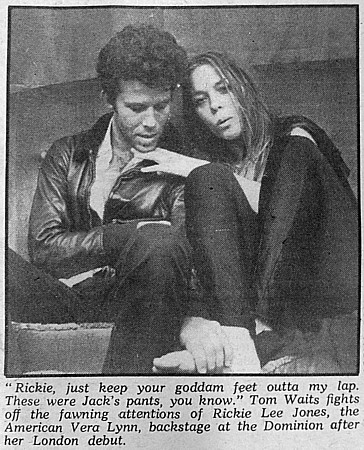
Dominion Theatre, London/ U.K.. September 9, 1979.
Credits: photography by Adrian Boot
Rickie Lee Jones (2007): "...Success affected me in a negative way. The fame and fortune intensified all the feelings I already had, especially the loneliness. As a girl. I hadn't really had the best life. So I didn't have any confidence at all... I started feeling more insecure as my career began. Maybe it's the influence of other people who were more dominant, without naming names [laughs]. I was larger than life, jumping around all over the place. When I look back at the films of that first tour. I'm a very sexy and wild girl onstage. And it's very real. It's an act, but I really am that girl. But I did not now how to put it down. It was a hard way to be."(23)
Mid 1979 Warner released three video clips promoting: Chuck E's In Love, Young Blood and Coolsville (from Jones' album "Rickie Lee Jones"). In these videos Jones portrays an innocent and vulnerable looking city girl walking the streets with her friend, while a sleazy Waits look-alike is stalking them from his car. The comparison with Waits must have been pretty obvious in 1979 (Jones and Waits dating had received considerable media attention). It seems like Jones felt she had to send an ugly message. Making fun of Chuck E. Weiss (in “Chuck E’s In Love”) and depicting Waits as a sleazy stalker, might have contributed to their break up.
Chuck E. Weiss (2007): "...I don't know how many millions that first album sold, but it affected all three of us in a very strange way. It helped split up our friendship for a while. There was a lot of emotional stuff goin' on with us. It had to do with her success and we were all taking drugs and getting high. We were taking anything we could get our hands on. And that intensified the drama of it. Things were never really normal again after that. She [Jones] just couldn't handle it, man. The record company were making such a fuss over her. They more or less chose to ignore some of the heavy drug use that was goin on. I thought that was bullshit, that they wouldn't pay attention to that, As long as she kept producing the songs, it didn't matter to them. It was a harsh lesson."(23)
Late 1979 Waits had reached the low point of his life. A planned movie project with Paul Hampton was not going to happen. His contribution to Sylvester Stallone's Paradise Alley was reduced to a minor cameo. In spite of all the touring Blue Valentine had not turned into a commercial success. In May Waits tried writing his next album (to be released late 1979) but it just didn't work. He was fed up with the music industry and its money oriented business men like Herb Cohen. He was disappointed, disillusioned and trying to get a grip on life. The Tropicana had turned into an amusement park for rockstars. Waits had released 6 albums with only minor success, he needed a change. In January 1980 Waits fled to New York, looking for a new environment, wanting to challenge himself, maybe looking for a new producer (Jack Nitzche). Waits was sick, and he had to fight some serious addictions. For the first time since his debut, there was not going to be a new Tom Waits album that year...
Robert Hilburn (1999): "...Waits moved to New York around 1980, partly to shed some of the hard-drinking L.A. habits, even enrolling in a fitness class. Smiling as he recalls an image from that period, he says, "I was running down the street to the Y to work out and I had a glass of alcohol in one hand, with some aluminum foil over it so it wouldn't spill, and a cigarette in the other hand, . . . and I realized I was kind of coming apart."(10)
Tom Waits (1981): "...I just got totally disenchanted with the music business. I moved to New York and was seriously considering other possible career alternatives... The whole Modus Operandi" - he made it sound like a particularly militant branch of the Casa Nostra - "of sitting down and writing, and making an album, going out on the road with a band. Away for three months, come back with high blood pressure, a drinking problem, tuberculosis, a warped sense of humour. It just became predictable."(24)
Waits and Jones probably broke up late 1979. At around the same time Waits met his future wife Kathleen Brennan at a New Years Eve party thrown by Art Fein. Early 1980 (while still in New York) Waits was approached by Francis Ford Coppola to work on the soundtrack for One From The Heart. In April 1980 he returned from New York to L.A. and moved in the Zoetrope studio's. This is where he met Kathleen Brennan again. They married August 10, 1980.
Rickie Lee Jones (late 1979): "...I depend on my imagination to keep me happy. That's why I prefer the nighttime to the daytime; it's easier to picture life in different ways. You fill in the darkness, and L.A. is very quiet and empty at night. Things I saw as a little girl convinced me I need to be this way to survive. I never knew that life was so serious and hard an cruel. You can't depend on anything at all."(4)

Rickie Lee Jones at the 22nd Annual Grammy awards ceremony at the Shrine Auditorium in Los Angeles, February 1980
Source: "Waiting For The Sun". Barney Hoskyns, 1996
Both Waits and Jones must have had feelings hurt and must have gone through some difficult times. Waits however was lucky enough to be rescued by Kathleen Brennan and by Coppola offering him to work on the soundtrack for One From The Heart, which kept him occupied through 1980 and which gave him the opportunity to clean up and get organized. Rickie Lee Jones won a Grammy for "Best New Artist" in 1979. In 1980 she moved to New York too. In 1981 she released her next album entitled Pirates.
Barney Hoskyns (2009): "...Pirates was a testament to overpowering grief, perfectly described by Rolling Stone's Stephen Holden as "explosively passionate and exhilaratingly eccentric." "I think you picked this up in Mexico from your dad," she sang on "We Belong Together," dispelling any doubt as to who she was singing about. In "A Lucky Guy" she foolishly told Waits she loved him, her girlish soprano only underscoring the sense of unrequited adoration. "Living It Up" told the tale of the Waits-Weiss-Jones triad, casting them as Louie, Eddie, and Zero. On the sublime "Traces Of The Western Slopes" she sang of the extremes of grief"(32)
Timothy White (1984): "...When her much-publicized romance with Tom Waits ended in 1980, she became physically ill with grief, and spent months in a daze of heartsickness. Plunging herself into the completion of Pirates, itself a partial diary of the breakup, she grew close with musician chum Sal Bernardi, with whom she wrote "Traces Of The Western Slopes."(12)
Rickie Lee Jones (1984): "...I think she (the Rickie Lee Jones who made the first album) was a lot more special than I ever knew, 'cause I didn't think she was very pretty or smart. She was real scared of everybody and everything, every staircase she walked down, every move she made, every word she said. But also, she was highly motivated by fear; one doesn't exist without the other... It was really important to me to assume a character, probably all the way, even in my personal life. I thought that plain, ordinary me, just standing here, wasn't enough of a character, so I made up something more readily identifiable... It (the beret) was a prop. I used to say that I could send the beret out to buy ice cream, to make personal appearances, to get things done, because people didn't recognize me, they only recognized the hat. And if I was afraid that I wouldn't be able to get into a concert, I'd wear my beret. I like that hat, but I swear, when I put it on, it weighed ten pounds. After a while, I couldn't stand to feel it on my head, and I couldn't wait to get it off."(12)
Both Waits and Jones have been reluctant to discuss their relationship. In retrospect, this "failed romance" marked the end of an era Waits would be associated with for the rest of his life. Soon Waits would start all over again as a man reborn. In 1983 Rickie Lee Jones released "Girl At Her Volcano" (Warner Bros.) The album features Rainbow Sleeves, written by Waits in 1978..
<object classid="CLSID:22d6f312-b0f6-11d0-94ab-0080c74c7e95" codebase="http://activex.microsoft.com/activex/controls/mplayer/en/nsmp2inf.cab#%20Version=5,1,52,701" height="46" id="MediaPlayer1" standby="Loading Microsoft Windows® Media Player components..." type="application/x-oleobject" width="320"><embed autostart="0" height="46" name="MediaPlayer1" pluginspage="http://www.microsoft.com/Windows/MediaPlayer/" showcontrols="1" src="http://www.tomwaitslibrary.info/audio/rainbowsleeves-excerpt.m3u" type="application/x-mplayer2" volume="-300" width="320"></embed> </object>
Listen to audio excerpt of Rainbow Sleeves as sung by Rickie Lee Jones.
Taken from "Girl At Her Volcano" (WEA, 1983).
Simon Hattenstone (2003): "...Does it upset her that people still ask about her relationship with him [Waits]? "Yep," she says. Silence. "It's like, 'Isn't there anything else here you want to know?' I knew that guy for a year 24 years ago, and they're still asking me about it. Someone left a message on my website saying, 'I've created a page on Tom and Rickie - maybe you'd like to go and look'." Actually, she says, she can't be bothered to be angry about it any more. "He [Waits] said something nice - maybe the reason people are so obsessed with this, maybe it wasn't a great love affair, maybe it's just all mythology, just part of their pop thing. I guess I would only have my heart hurt if I thought they're asking me but they're not asking him. Because then it feels disrespectful." She pauses. "Then I thought, he's so scary they wouldn't dare ask him."(14)
Rickie Lee Jones (2007): "...What's intrinsic about me is that I'm always changing. My life is just how the music is. There's an urgency about it that, frankly I could do without. But then it probably feeds my ability to keep working. There's something truly bohemian about who l am. The way l grew up was so transient that it made this human being who might have to pack up and run away at any moment."(23)
Late 1979 Chuck E. Weiss, formed this band called: "Chuck E. Weiss and the goddamn liars". They only seemed to perform in the LA district (at the old "Central", now the "Viper Room" and "Highland Grounds"). One wonders if the two ever met in the 80's. Waits: married, having the Frito-Lay money, artistically developing, traveling the world. And Weiss: staying in LA, playing the same clubs night after night... Weiss got the regular Monday night gig at the popular Hollywood dive called the Central. He played there for eleven years before the place hit hard times. It was about to close down when Chuck called his friend, actor Johnny Depp.(3) The new club Weiss and Depp put together on the site of the old Central on Sunset Boulevard became the instantly trendy Viper Room. It quickly became a favorite haunt where Hollywood's young and beautiful set could mingle amongst some of the town's seedier rock and roll elements. The Viper Room became a huge success, even weathering the tragedy of actor River Phoenix dying outside the club in 1993.
In 1981 a first album by Chuck E. Weiss was released called: "The Other Side Of Town" (Select Records, SEL21611. Re-released in 2007). It was only a demo tape that was released against Weiss' wishes, and was pulled off the market soon afterwards. The album features a duet with Ricki Lee Jones (Sidekick) and Dr. John plays the keyboards. Tracklisting: Luigi's Starlite Lounge, Saturday Nite Fish Fry, Sidekick, Gina, Tropicana, Sparky, Juvenile Delinquent, The Other Side of Town.
Art Fein (2003): "...In 1970, Chuck had recorded some songs at Chess in Chicago with Willie Dixon's band, and an album was released on Rollin' Rock. I didn't think much of his singing or the idea of him recording with the 'masters.' In 1979 when Rickie Lee Jones recorded Chuck E's In Love, I called a guy at Mercury Records in Chicago and said "I've got Chuck E." He said he'd pay $5000 for a Chuck Weiss single if it could come out fast. I told Chuck and he said, "Uh uh, I'm doing my own album; my cousin from Denver is producing it." The "opening" -- interest in "Chuck E" -- demanded immediate response. Chuck's was anything but. His album was recorded a year later, and came out the year after that. Recording circumstances were not ideal, nor was the recorder: I recall seeing him carried out of Canter's deli the night before the sessions, intoxicated. This resultant album didn't kill me either."(1)
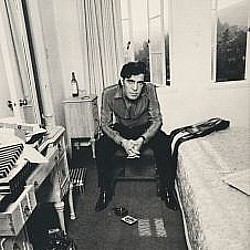
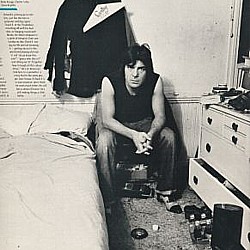
Chuck E. Weiss on the front and back cover of "The Other Side Of Town", Select Records 1981
Chuck E's Not In Love With Rerelease
By JOHN ROGERS. Associated Press. October 23, 2007
LOS ANGELES — It turns out there's something Chuck E's not in love with. It's his "The Other Side of Town" album. The work, out of print for decades, suddenly re-emerged this month, and Chuck E. Weiss wasn't happy. "It's not that good, man," said the musician and Hollywood hipster best known as the musical muse for Rickie Lee Jones' 1979 song, "Chuck E's in Love." "Lyrically, I think it's disappointing," Weiss told The Associated Press. "Musically, some of those things are OK, but they're mere skeletons of what I thought the songs should be." To his surprise, "The Other Side of Town," which includes a duet with Jones and rollicking piano contributions from Dr. John, has generally gotten good reviews. "It's full of great wit, charm and an utter carelessness that makes it feel dangerous in a time when music is anything but," said Thom Jurek of allmusic.com. Fred Munao, president of New Jersey-based Select Records, said he was remiss not to contact Weiss before reissuing the album made up of 1981 demos. He otherwise makes no apologies. "Chuck E has some reservations about it, but I think it's a much lovelier record than he acknowledges," Munao said. "Chuck E epitomizes what is very much a lost version of cool." Bringing it back, he added, was something the label's younger audience wanted. Having heard the near-mythic tales of Weiss' collaborations with Muddy Waters, Willie Dixon, Howlin' Wolf, Tom Waits and others, they were disappointed to learn he's recorded only three other albums of his own. Legendary or not, Weiss said, he still hasn't been paid for this one. That's something else he wasn't happy about. Munao said Weiss will eventually receive "a lot more than he got last time" for the record, but the musician remained skeptical. "Maybe it will be enough I can buy McDonald's burgers for all the people in my courtyard," he joked.
Tom Waits (1988): "...I've known Chuck for about a hundred years. I go down there to the Central and see Chuck E Weiss and The Goddamn Liars, that's a damn good show, a good place to be on Monday nights."(13)
On May 30 1992 Waits and Weiss both appeared at the LA Riot Benefit at the "Wiltern Theatre ", Los Angeles. In the meantime, Weiss had been writing and singing, but he never seemed to get around to recording his stuff. Weiss also wasn't building on his reputation outside LA, because he hardly ever toured due to a fear of flying. Weiss, doing his regular club gigs, some acting (1989/1990 Married with Children!), and some movie scoring. He penned several tracks for various film and television projects including "The Brave", starring Johnny Depp and Marlon Brando, the cult flick "Dabeateo", the Judge Reinhold, Willem Dafoe feature "Roadhouse", as well as the theme for Showtime's "Rude Awakening". But finally Waits intervened. In 1998 he got Weiss to go into the studio and agreed to co-produce and sing on his album, which became 'Extremely Cool' (released February 2, 1999).
Art Fein (2003): "...In late 1978 some friends and I began producing private New Years parties, and Chuck and Waits came to the first two. Tom met his wife at the second one, which featured Roy Brown. In 1984 I supplied outside music for the film "Roadhouse 66" (which includes James Intveld's band in the live footage, and a 5-second close-up of me) including three Chuck Weiss songs which I 'produced' (stood around and said OK) at an 8-track studio in Culver City. Then in the late 80s he began playing midnight Mondays at The Central on Sunset Strip. I came to every show, and they were phenomenal and wildly popular. Stars would come out to see Chuck! And as I learned his stuff and his style, I went back and studied the 1980 album again. Now I got it: he really did have talent as both a singer and songwriter. I just missed it the first time."(1)
During his 18 years away from recording, Chuck E. had occasional dialogue with record companies, none of which truly appreciated his musical uniqueness. Finally in 1998 the Slow River imprint of Rykodisc heard Chuck E.'s demos, embraced his non-traditional rock 'n' roll persona, and work commenced on the new album. "I listened originally because Waits produced and performs on the record and I'm a huge fan of what Tom does," said Slow River President George Howard. "But soon that connection became secondary to the music, which is a truly original and vital synthesis of some of the finest strands of American music I have ever heard. My respect and appreciation for Chuck and his music and for what he means as the torchbearer for a dying breed of musicians has grown with each listen. I'm honored to have him on my label." (15)
Tom Waits (1999): "...I've met Chuck E. in about 1974, you know out in front of Ebbet's Field. And so that record was really a labour of love. Chuck E. did most of the work you know. We put up the money and my wife shopped it around and got a lot of interest. You know I'm glad it came out. Everybody seemed to love it. It got a lot of great reviews. He played a lot of shows and ehm... So I was real happy for him. It's really a bizarre combination of eh... it's just like Chuck you know? So it's like sick and touching and loud and you know it's... So I was real glad it came out."(19)
Tom Waits (2002): "...Chuck E. Weiss is a mensch, a liar, a monkey, and a pathological Vaudevillian. He is a distant relative of Houdini's; he's a praying mantis riding an egret through a bad neighborhood. He's a reverend waving a pistol around. Basically, he's in the salvage business and you should do everything he tells you."(21)
Q: Why did it take 18 years to get around to making another record?
Chuck E. Weiss (1999): "...Well, you could say I got distracted. If you really want to know, I just didn't like to associate myself with what was going on in the record business in those days. Over the years, I've had a lot of people [make] some very strange suggestions to me that I didn't like. There was always some sort of catch. 'What you see is what you get' is what I always thought I was, and over the years somebody would always want to do something that was not according to my own principles. Once there was a guy that wanted me to do a duet album with Sandra Bernhard. Then there was a guy who wanted me to be one of the Blues Brothers. You don't know me, but neither one of those things is what I'd want to do. Over the years nothing seemed to click, so nothing really happened. My buddy Tom Waits was always trying to get me to go into the studio, and I'd go in the studio and then the tapes would just kinda like sit there, 'cause I didn't have a manager, didn't want to hustle them. I just figured that when the time was right, I'd be with a record company... When I was growing up, if you heard something on the radio, and you liked the music, you didn't care what the artist looked like. Now it's more visual. Maybe I don't adhere to the visual part."(16)
Weiss credits Waits for helping get his act in gear:
"He was really a mentor, telling me what I needed to do to get it done.
It's kinda like Snoop and Dr. Dre!"(17)
|
|
|
|
Chuck E. Weiss 1999 promo picture |
Rickie Lee Jones 2003 promo picture (detail) |
Notes:
(1) Source: "Another Fein Mess/ Other Fein Messes" by Art Fein. March, 2003. Copyright Art Fein
(2) Source: "Chuck E. Weiss Artist Showcase". imusic, 1999
(3) Source: "Chuck E.'s In Love". Jay S. Jacobs. Popentertainment.com, 1999
(4) Source: "Rock Lives, Profiles and Interviews". Interview w. Rickie Lee Jones from late 1979. Timothy White. Omnibus, 1992
(5) Source: top picture Rykodisc Chuck E. Weiss Official Site � Copyright 1999 Rykodisc. Source bottom picture: Source: Steve Clark at Rockabilly Hall Of Fame. Credits: photography by Jenny Lens (kind permission Steve Clark/ Jenny Lens)
(6) Source: Rickie Lee Jones Official Web Site. � Copyright 2000 Rickie Lee Jones
(7) Source: "Furniture For The People" message board. April 14, 2003. "Question for Rickie Lee"
(8) Source: unknown. Date: Dominion Theatre London. September 9, 1979 (with Rickie Lee Jones). Credits: photography by Adrian Boot. Thanks to Ken Langford for donating scan
(9) Source: "The Neon Dreams Of Tom Waits". "New Musical Express" magazine. John Hamblett. London. May 12, 1979
(10) Source: "Pop music: Tracking an Elusive Character" Los Angeles Times Home Edition. Robert Hilburn. June 6 1999. Robert Durell
(11) Source: "Waiting For The Sun". Barney Hoskyns, 1996. Penguin Books. ISBN 0-670-85021-7
(12) Source: Musician Magazine, The Real End of a Long Beginning. Interview by Timothy White. Date ca. 1984
(13) Source: "KCRW-FM: Morning Becomes Eclectic" Date: October 3, 1988
(14) Source: "The devil and Miss Jones". Simon Hattenstone. October 18, 2003 The Guardian
(15) Source: "Chuck E. Weiss: Extremely Cool". Greg Bottoms. New Buzz - Music Review, 1999
(16) Source: "Toban talks to quasi-legend of L.A. singer/songwriter scene". Kevin Matthews, January 27, 1999
(17) Source: "When the Gig Ended, His New Career Began". L.A. Times ~ Calendar ~ Sunday, January 27, 2002. Marc Weingarten
(18) The Tropicana as pictured on the cover for "Step Right Up: The songs of Tom Waits" (Manifesto Records, 1995). Picture credit: courtesy of Art Fein
(19) Source: "KBCO Interview With Tom Waits" KBCO-C studios Los Angeles (USA), by Bret Saunders. October 13, 1999
(20) Source: email Lisa Clark to Tom Waits Library. February 3, 2005). Probably sessions for "The Other Side Of Town"
(21) Source: "Chuck E. Weiss: Mensch, Monkey, And Liar", Philadelphia Inquirer/ Denver Post, 2002. By Rip Rense
(22) Photo credit: Jenny Lens. Further reading: Jenny Lens Punk Archive
(23) Source: "Interview with Rickie Lee Jones". By Rob Hughes, Uncut magazine, april 2007
(24) Source: "Heart Of Saturday Morning" Melody Maker. March 14, 1981 by Patrick Humphries
(25) Source: "Chuck E's Still In Love _ With Life". Associated Press. April 9, 2007
(26) Source: Paul Body interview March 9, 2007 as quoted in “Lowside Of The Road: A Life Of Tom Waits" by Barney Hoskyns. Faber/ Broadway, 2009
(27) Source: Robert Marchese interview May 18, 2007 as quoted in “Lowside Of The Road: A Life Of Tom Waits" by Barney Hoskyns. Faber/ Broadway, 2009
(28) Source: Bones Howe interview March 13, 2007 as quoted in “Lowside Of The Road: A Life Of Tom Waits" by Barney Hoskyns. Faber/ Broadway, 2009
(29) Source: Mike Melvoin interview March 20, 2007 as quoted in “Lowside Of The Road: A Life Of Tom Waits" by Barney Hoskyns. Faber/ Broadway, 2009
(30) Source: Bobi Thomas email interview June 13, 2007 as quoted in “Lowside Of The Road: A Life Of Tom Waits" by Barney Hoskyns. Faber/ Broadway, 2009
(31) Source: Rob Hughes Uncut. April 2007 as quoted in “Lowside Of The Road: A Life Of Tom Waits" by Barney Hoskyns. Faber/ Broadway, 2009
(32) Source: “Lowside Of The Road: A Life Of Tom Waits" by Barney Hoskyns. Faber/ Broadway, 2009



